List of birds of the Cayman Islands
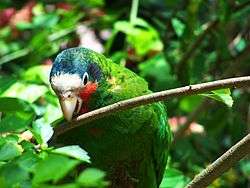
This is a list of the bird species recorded in the Cayman Islands. The avifauna of the Cayman Islands include a total of 244 species, of which 98 are rare or accidental and four are introduced. One species (Grand Cayman thrush) is globally extinct and one species (Jamaican oriole) is extirpated in the Cayman Islands.[1] There are no surviving endemic species although the islands hold most of the world population of vitelline warbler which otherwise occurs only on the Swan Islands in Honduras.[1] There are 17 endemic subspecies belonging to 14 different species.[1]
This list's taxonomic treatment (designation and sequence of orders, families and species) and nomenclature (common and scientific names) follow the conventions of The Clements Checklist of Birds of the World, 6th edition. The family accounts at the beginning of each heading reflect this taxonomy, as do the species counts found in each family account. Accidental species are included in the total species count for the Cayman Islands.
The following tags have been used to highlight several categories. The commonly occurring native species do not fall into any of these categories.
- (A) Accidental - a species that rarely or accidentally occurs in the Cayman Islands
- (E) Endemic - a species endemic to the Cayman Islands
- (Ex) Extirpated - a species that no longer occurs in the Cayman Islands although populations exist elsewhere
| Table of contents |
|---|
|
Non-passerines: Grebes • Shearwaters and petrels • Tropicbirds • Pelicans • Boobies • Cormorants • Darters • Frigatebirds • Bitterns, herons and egrets • Ibises and spoonbills • Flamingos • Ducks and geese • New World vultures • Osprey • Hawks and kites • Falcons • Rails, crakes, gallinules and coots • Limpkin • Avocets and stilts • Plovers • Sandpipers and allies • Skuas and jaegers • Gulls, terns and skimmers • Pigeons and doves • Parrots • Cuckoos and anis • Barn owls • Typical owls • Nightjars • Swifts • Hummingbirds • Kingfishers • Woodpeckers and allies |
|
Passerines: Tyrant flycatchers • Swallows and martins • Waxwings • Mockingbirds and allies • Thrushes and allies • Gnatcatchers • Starlings • Vireos • New World warblers • Bananaquit • Tanagers • New World sparrows and allies • Cardinals and allies • New World blackbirds and allies • Old World sparrows |
Grebes

Order: Podicipediformes Family: Podicipedidae
Grebes are small to medium-large freshwater diving birds. They have lobed toes and are excellent swimmers and divers. However, they have their feet placed far back on the body, making them quite ungainly on land.
- Least grebe, Tachybaptus dominicus (A)
- Pied-billed grebe, Podilymbus podiceps
Shearwaters and petrels
Order: Procellariiformes Family: Procellariidae
The procellariids are the main group of medium-sized "true petrels", characterised by united nostrils with medium septum and a long outer functional primary.
- Black-capped petrel, Pterodroma hasitata (A)
- Greater shearwater, Puffinus gravis (A)
- Audubon's shearwater, Puffinus lherminieri (A)
Tropicbirds

Order: Pelecaniformes Family: Phaethontidae
Tropicbirds are slender white birds of tropical oceans, with exceptionally long central tail feathers. Their heads and long wings have black markings.
- White-tailed tropicbird, Phaethon lepturus
Pelicans
Order: Pelecaniformes Family: Pelecanidae
Pelicans are large water birds with a distinctive pouch under their beak. As with other members of the order Pelecaniformes, they have webbed feet with four toes.
- American white pelican, Pelecanus erythrorhynchos (A)
- Brown pelican, Pelecanus occidentalis
Boobies
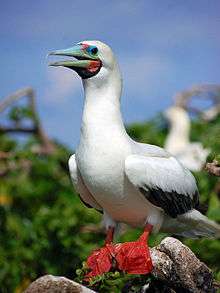
Order: Pelecaniformes Family: Sulidae
The sulids comprise the gannets and boobies. Both groups are medium to large coastal seabirds that plunge-dive for fish.
- Masked booby, Sula dactylatra (A)
- Red-footed booby, Sula sula
- Brown booby, Sula leucogaster
Cormorants
Order: Pelecaniformes Family: Phalacrocoracidae
Phalacrocoracidae is a family of medium to large coastal, fish-eating seabirds that includes cormorants and shags. Plumage colouration varies, with the majority having mainly dark plumage, some species being black-and-white and a few being colourful.
- Double-crested cormorant, Phalacrocorax auritus
Darters
Order: Pelecaniformes Family: Anhingidae
Darters are often called "snake-birds" because of their long thin neck, which gives a snake-like appearance when they swim with their bodies submerged. The males have black and dark-brown plumage, an erectile crest on the nape and a larger bill than the female. The females have much paler plumage especially on the neck and underparts. The darters have completely webbed feet and their legs are short and set far back on the body. Their plumage is somewhat permeable, like that of cormorants, and they spread their wings to dry after diving.
- Anhinga, Anhinga anhinga (A)
Frigatebirds
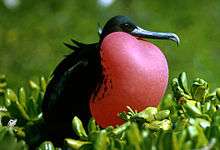
Order: Pelecaniformes Family: Fregatidae
Frigatebirds are large seabirds usually found over tropical oceans. They are large, black-and-white or completely black, with long wings and deeply forked tails. The males have coloured inflatable throat pouches. They do not swim or walk and cannot take off from a flat surface. Having the largest wingspan-to-body-weight ratio of any bird, they are essentially aerial, able to stay aloft for more than a week.
- Magnificent frigatebird, Fregata magnificens
Bitterns, herons and egrets
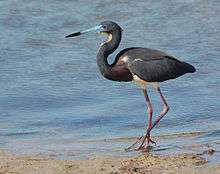
Order: Ciconiiformes Family: Ardeidae
The family Ardeidae contains the bitterns, herons and egrets. Herons and egrets are medium to large wading birds with long necks and legs. Bitterns tend to be shorter necked and more wary. Members of Ardeidae fly with their necks retracted, unlike other long-necked birds such as storks, ibises and spoonbills.
- Great blue heron, Ardea herodias
- Great egret, Ardea alba
- Reddish egret, Egretta rufescens (A)
- Tricoloured heron, Egretta tricolor
- Little blue heron, Egretta caerulea
- Snowy egret, Egretta thula
- Cattle egret, Bubulcus ibis
- Green heron, Butorides virescens
- Black-crowned night-heron, Nycticorax nycticorax
- Yellow-crowned night-heron, Nyctanassa violacea
- Least bittern, Ixobrychus exilis
- American bittern, Botaurus lentiginosus (A)
Ibises and spoonbills
Order: Ciconiiformes Family: Threskiornithidae
Threskiornithidae is a family of large terrestrial and wading birds which includes the ibises and spoonbills. They have long, broad wings with 11 primary and about 20 secondary feathers. They are strong fliers and despite their size and weight, very capable soarers.
- American white ibis, Eudocimus albus (A)
- Glossy ibis, Plegadis falcinellus
- Roseate spoonbill, Platalea ajaja (A)
Flamingos
Order: Phoenicopteriformes Family: Phoenicopteridae
Flamingos are gregarious wading birds, usually 3 to 5 feet (0.9 to 1.5 m) tall, found in both the Western and Eastern Hemispheres. Flamingos filter-feed on shellfish and algae. Their oddly shaped beaks are specially adapted to separate mud and silt from the food they consume and, uniquely, are used upside-down.
- Caribbean flamingo, Phoenicopterus ruber (A)
Ducks and geese
_RWD2.jpg)

Order: Anseriformes Family: Anatidae
Anatidae includes the ducks and most duck-like waterfowl, such as geese and swans. These birds are adapted to an aquatic existence with webbed feet, flattened bills, and feathers that are excellent at shedding water due to an oily coating.
- Fulvous whistling-duck, Dendrocygna bicolor (A)
- West Indian whistling-duck, Dendrocygna arborea
- Black-bellied whistling-duck, Dendrocygna autumnalis (A)
- Canada goose, Branta canadensis (A)
- Wood duck, Aix sponsa (A)
- Gadwall, Anas strepera (A)
- American wigeon, Anas americana
- Green-winged teal, Anas crecca (A)
- Mallard, Anas platyrhynchos (A)
- Northern pintail, Anas acuta (A)
- White-cheeked pintail, Anas bahamensis (A)
- Blue-winged teal, Anas discors
- Northern shoveler, Anas clypeata
- Redhead, Aythya americana (A)
- Ring-necked duck, Aythya collaris
- Lesser scaup, Aythya affinis
- Red-breasted merganser, Mergus serrator (A)
- Hooded merganser, Lophodytes cucullatus (A)
- Masked duck, Nomonyx dominica (A)
- Ruddy duck, Oxyura jamaicensis (A)
New World vultures
Order: Falconiformes Family: Cathartidae
The New World vultures are not closely related to Old World vultures, but superficially resemble them because of convergent evolution. Like the Old World vultures, they are scavengers. However, unlike Old World vultures, which find carcasses by sight, New World vultures have a good sense of smell with which they locate carrion.
- Turkey vulture, Cathartes aura (A)
Osprey

Order: Falconiformes Family: Pandionidae
The Pandionidae family contains only one species, the osprey. The osprey is a medium-large raptor which is a specialist fish-eater with a worldwide distribution.
- Osprey, Pandion haliaetus
Hawks and kites
Order: Falconiformes Family: Accipitridae
Accipitridae is a family of birds of prey, which includes hawks, eagles, kites, harriers and Old World vultures. These birds have powerful hooked beaks for tearing flesh from their prey, strong legs, powerful talons and keen eyesight.
- Swallow-tailed kite, Elanoides forficatus
- Northern harrier, Circus cyaneus
- Red-tailed hawk, Buteo jamaicensis (A)
Falcons

Order: Falconiformes Family: Falconidae
Falconidae is a family of diurnal birds of prey. They differ from hawks, eagles and kites in that they kill with their beaks instead of their talons.
- American kestrel, Falco sparverius
- Merlin, Falco columbarius
- Peregrine falcon, Falco peregrinus
Rails, crakes, gallinules and coots

Order: Gruiformes Family: Rallidae
Rallidae is a large family of small to medium-sized birds which includes the rails, crakes, coots and gallinules. Typically they inhabit dense vegetation in damp environments near lakes, swamps or rivers. In general they are shy and secretive birds, making them difficult to observe. Most species have strong legs and long toes which are well adapted to soft uneven surfaces. They tend to have short, rounded wings and to be weak fliers.
- Sora, Porzana carolina
- Purple gallinule, Porphyrio martinica
- Common gallinule, Gallinula galeata
- American coot, Fulica americana
- Caribbean coot, Fulica caribaea
Limpkin
Order: Gruiformes Family: Aramidae
- Limpkin, Aramus guarauna (A)
Avocets and stilts

Order: Charadriiformes Family: Recurvirostridae
Recurvirostridae is a family of large wading birds, which includes the avocets and stilts. The avocets have long legs and long up-curved bills. The stilts have extremely long legs and long, thin, straight bills.
- Black-necked stilt, Himantopus mexicanus
- American avocet, Recurvirostra americana (A)
Plovers
_RWD.jpg)
Order: Charadriiformes Family: Charadriidae
The family Charadriidae includes the plovers, dotterels and lapwings. They are small to medium-sized birds with compact bodies, short, thick necks and long, usually pointed, wings. They are found in open country worldwide, mostly in habitats near water.
- American golden-plover, Pluvialis dominica (A)
- Black-bellied plover, Pluvialis squatarola
- Semipalmated plover, Charadrius semipalmatus
- Wilson's plover, Charadrius wilsonia
- Killdeer, Charadrius vociferus
- Snowy plover, Charadrius nivosus (A)
Sandpipers and allies
_(6326197441).jpg)

Order: Charadriiformes Family: Scolopacidae
Scolopacidae is a large diverse family of small to medium-sized shorebirds including the sandpipers, curlews, godwits, shanks, tattlers, woodcocks, snipes, dowitchers and phalaropes. The majority of these species eat small invertebrates picked out of the mud or soil. Variation in length of legs and bills enables multiple species to feed in the same habitat, particularly on the coast, without direct competition for food.
- Wilson's snipe, Gallinago delicata
- Short-billed dowitcher, Limnodromus griseus
- Long-billed dowitcher, Limnodromus scolopaceus (A)
- Marbled godwit, Limosa fedoa (A)
- Whimbrel, Numenius phaeopus
- Upland sandpiper, Bartramia longicauda (A)
- Greater yellowlegs, Tringa melanoleuca
- Lesser yellowlegs, Tringa flavipes
- Solitary sandpiper, Tringa solitaria
- Willet, Tringa semipalmata
- Spotted sandpiper, Actitis macularia
- Ruddy turnstone, Arenaria interpres
- Red knot, Calidris canutus (A)
- Buff-breasted sandpiper, Calidris subruficollis (A)
- Sanderling, Calidris alba
- Semipalmated sandpiper, Calidris pusilla
- Western sandpiper, Calidris mauri
- Least sandpiper, Calidris minutilla
- White-rumped sandpiper, Calidris fuscicollis
- Baird's sandpiper, Calidris bairdii (A)
- Pectoral sandpiper, Calidris melanotos
- Dunlin, Calidris alpina (A)
- Stilt sandpiper, Calidris himantopus
- Ruff, Calidris pugnax (A)
- Wilson's phalarope, Phalaropus tricolor (A)
Skuas and jaegers
Order: Charadriiformes Family: Stercorariidae
The family Stercorariidae are, in general, medium to large birds, typically with grey or brown plumage, often with white markings on the wings. They nest on the ground in temperate and arctic regions and are long-distance migrants.
- Long-tailed jaeger, Stercorarius longicaudus (A)
Gulls, terns and skimmers
_RWD1.jpg)
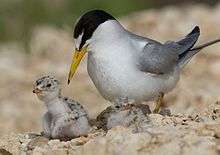
Order: Charadriiformes Family: Laridae
Laridae is a family of medium to large seabirds and includes gulls, kittiwakes, terns and skimmers. They are typically grey or white, often with black markings on the head or wings. They have longish bills and webbed feet. Terns are a group of generally medium to large seabirds typically with grey or white plumage, often with black markings on the head. Most terns hunt fish by diving but some pick insects off the surface of fresh water. Terns are generally long-lived birds, with several species known to live in excess of 30 years. There are 44 species worldwide and 11 species which occur in the Cayman Islands. Skimmers are a small family of tropical tern-like birds. They have an elongated lower mandible which they use to feed by flying low over the water surface and skimming the water for small fish.
- Ring-billed gull, Larus delawarensis (A)
- Lesser black-backed gull, Larus fuscus (A)
- Herring gull, Larus argentatus
- Bonaparte's gull, Chroicocephalus philadelphia (A)
- Laughing gull, Leucophaeus atricilla
- Gull-billed tern, Gelochelidon nilotica
- Caspian tern, Hydroprogne caspia (A)
- Sandwich tern, Thalasseus sandvicensis
- Royal tern, Thalasseus maxima
- Roseate tern, Sterna dougallii (A)
- Common tern, Sterna hirundo
- Forster's tern, Sterna forsteri (A)
- Least tern, Sternula antillarum
- Bridled tern, Onychoprion anaethetus
- Sooty tern, Onychoprion fuscata (A)
- Black tern, Chlidonias niger
- Brown noddy, Anous stolidus (A)
- Black skimmer, Rynchops niger (A)
Pigeons and doves

Order: Columbiformes Family: Columbidae
Pigeons and doves are stout-bodied birds with short necks and short slender bills with a fleshy cere.
- Rock dove, Columba livia (I)
- White-crowned pigeon, Patagioenas leucocephala
- Mourning dove, Zenaida macroura
- Zenaida dove, Zenaida aurita
- White-winged dove, Zenaida asiatica
- Common ground-dove, Columbina passerina
- Caribbean dove, Leptotila jamaicensis
Parrots
Order: Psittaciformes Family: Psittacidae
Parrots are small to large birds with a characteristic curved beak. Their upper mandibles have slight mobility in the joint with the skull and they have a generally erect stance. All parrots are zygodactyl, having the four toes on each foot placed two at the front and two to the back.
- Budgerigar, Melopsittacus undulatus (I)
- Monk parakeet, Myiopsitta monachus (I)
- Cuban amazon, Amazona leucocephala
Cuckoos and anis
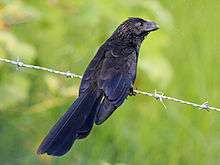
Order: Cuculiformes Family: Cuculidae
The family Cuculidae includes cuckoos, roadrunners and anis. These birds are of variable size with slender bodies, long tails and strong legs.
- Black-billed cuckoo, Coccyzus erythropthalmus (A)
- Yellow-billed cuckoo, Coccyzus americanus
- Mangrove cuckoo, Coccyzus minor
- Smooth-billed ani, Crotophaga ani
Barn owls
Order: Strigiformes Family: Tytonidae
Barn owls are medium to large owls with large heads and characteristic heart-shaped faces. They have long strong legs with powerful talons.
- Barn owl, Tyto alba
Typical owls

Order: Strigiformes Family: Strigidae
The typical owls are small to large solitary nocturnal birds of prey. They have large forward-facing eyes and ears, a hawk-like beak and a conspicuous circle of feathers around each eye called a facial disk.
- Short-eared owl, Asio flammeus
Nightjars
Order: Caprimulgiformes Family: Caprimulgidae
Nightjars are medium-sized nocturnal birds that usually nest on the ground. They have long wings, short legs and very short bills. Most have small feet, of little use for walking, and long pointed wings. Their soft plumage is camouflaged to resemble bark or leaves.
- Common nighthawk, Chordeiles minor (A)
- Antillean nighthawk, Chordeiles gundlachii
- Chuck-will's-widow, Antrostomus carolinensis (A)
Swifts
Order: Apodiformes Family: Apodidae
Swifts are small birds which spend the majority of their lives flying. These birds have very short legs and never settle voluntarily on the ground, perching instead only on vertical surfaces. Many swifts have long swept-back wings which resemble a crescent or boomerang.
- Black swift, Cypseloides niger (A)
- Chimney swift, Chaetura pelagica (A)
Hummingbirds
Order: Trochiliformes Family: Trochilidae
Hummingbirds are small birds capable of hovering in mid-air due to the rapid flapping of their wings. They are the only birds that can fly backwards.
- Ruby-throated hummingbird, Archilochus colubris (A)
Kingfishers

Order: Coraciiformes Family: Alcedinidae
Kingfishers are medium-sized birds with large heads, long, pointed bills, short legs and stubby tails.
- Belted kingfisher, Megaceryle alcyon
Woodpeckers and allies
Order: Piciformes Family: Picidae
Woodpeckers are small to medium-sized birds with chisel-like beaks, short legs, stiff tails and long tongues used for capturing insects. Some species have feet with two toes pointing forward and two backward, while several species have only three toes. Many woodpeckers have the habit of tapping noisily on tree trunks with their beaks.
- West Indian woodpecker, Melanerpes superciliaris
- Yellow-bellied sapsucker, Sphyrapicus varius
- Northern flicker, Colaptes auratus
Tyrant flycatchers
.jpg)
Order: Passeriformes Family: Tyrannidae
Tyrant flycatchers are passerine birds which occur throughout North and South America. They superficially resemble the Old World flycatchers, but are more robust and have stronger bills. They do not have the sophisticated vocal capabilities of the songbirds. Most, but not all, have plain colouring. As the name implies, most are insectivorous.
- Caribbean elaenia, Elaenia martinica
- Eastern wood-pewee, Contopus virens
- Acadian flycatcher, Empidonax virescens (A)
- Least flycatcher, Empidonax minimus (A)
- La Sagra's flycatcher, Myiarchus sagrae
- Eastern kingbird, Tyrannus tyrannus (A)
- Grey kingbird, Tyrannus dominicensis
- Loggerhead kingbird, Tyrannus caudifasciatus
- Fork-tailed flycatcher, Tyrannus savana (A)
- Scissor-tailed flycatcher, Tyrannus forficatus(A)
- Eastern phoebe, Sayornis phoebe (A)
- Great crested flycatcher, Myiarchus crinitus (A)
- Tropical kingbird, Tyrannus melancholicus (A)
Swallows and martins
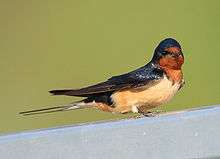
Order: Passeriformes Family: Hirundinidae
The family Hirundinidae is adapted to aerial feeding. They have a slender streamlined body, long pointed wings and a short bill with a wide gape. The feet are adapted to perching rather than walking, and the front toes are partially joined at the base.
- Purple martin, Progne subis
- Caribbean martin, Progne dominicensis (A)
- Tree swallow, Tachycineta bicolor
- Northern rough-winged swallow, Stelgidopteryx serripennis (A)
- Bank swallow, Riparia riparia
- Cliff swallow, Petrochelidon pyrrhonota (A)
- Cave swallow, Petrochelidon fulva (A)
- Barn swallow, Hirundo rustica
Waxwings
Order: Passeriformes Family: Bombycillidae
The waxwings are a group of birds with soft silky plumage and unique red tips to some of the wing feathers. In the Bohemian and cedar waxwings, these tips look like sealing wax and give the group its name. These are arboreal birds of northern forests. They live on insects in summer and berries in winter.
- Cedar waxwing, Bombycilla cedrorum
Mockingbirds and allies
Order: Passeriformes Family: Mimidae
The mimids are a family of passerine birds that includes thrashers, mockingbirds, tremblers and the New World catbirds. These birds are notable for their vocalizations, especially their ability to mimic a wide variety of birds and other sounds heard outdoors. Their colouring tends towards dull-greys and browns.
- Grey catbird, Dumetella carolinensis
- Northern mockingbird, Mimus polyglottos
Thrushes and allies
_RWD.jpg)
Order: Passeriformes Family: Turdidae
The thrushes are a group of passerine birds that occur mainly in the Old World. They are plump, soft plumaged, small to medium-sized insectivores or sometimes omnivores, often feeding on the ground. Many have attractive songs.
- Veery, Catharus fuscescens
- Swainson's thrush, Catharus ustulatus
- Wood thrush, Hylocichla mustelina (A)
- Red-legged thrush, Turdus plumbeus
- Grand Cayman thrush, Turdus ravidus (E, Extinct)
- Grey-cheeked thrush, Catharus minimus (A)
Gnatcatchers
Order: Passeriformes Family: Polioptilidae
These dainty birds resemble Old World warblers in their build and habits, moving restlessly through the foliage seeking insects. The gnatcatchers and gnatwrens are mainly soft bluish grey in colour and have the typical insectivore's long sharp bill. They are birds of fairly open woodland or scrub, which nest in bushes or trees.
- Blue-grey gnatcatcher, Polioptila caerulea (A)
Starlings
Order: Passeriformes Family: Sturnidae
Starlings are small to medium-sized passerine birds. Their flight is strong and direct and they are very gregarious. Their preferred habitat is fairly open country. They eat insects and fruit. Plumage is typically dark with a metallic sheen.
- European starling, Sturnus vulgaris (A)
Vireos
_(3).jpg)
Order: Passeriformes Family: Vireonidae
The vireos are a group of small to medium-sized passerine birds restricted to the New World. They are typically greenish in colour and resemble wood warblers apart from their heavier bills.
- White-eyed vireo, Vireo griseus
- Thick-billed vireo, Vireo crassirostris
- Yellow-throated vireo, Vireo flavifrons
- Philadelphia vireo, Vireo philadelphicus (A)
- Red-eyed vireo, Vireo olivaceus
- Black-whiskered vireo, Vireo altiloquus
- Yucatan vireo, Vireo magister
- Blue-headed vireo, Vireo solitarius (A)
New World warblers
.jpg)

Order: Passeriformes Family: Parulidae
The New World warblers are a group of small, often colourful, passerine birds restricted to the New World. Most are arboreal, but some are terrestrial. Most members of this family are insectivores.
- Blue-winged warbler, Vermivora cyanoptera
- Golden-winged warbler, Vermivora chrysoptera (A)
- Tennessee warbler, Oreothlypis peregrina
- Orange-crowned warbler, Oreothlypis celata (A)
- Nashville warbler, Oreothlypis ruficapilla (A)
- Northern parula, Setophaga americana
- Yellow warbler, Setophaga petechia
- Chestnut-sided warbler, Setophaga pensylvanica
- Magnolia warbler, Setophaga magnolia
- Cape May warbler, Setophaga tigrina
- Black-throated blue warbler, Setophaga caerulescens
- Yellow-rumped warbler, Setophaga coronata
- Black-throated green warbler, Setophaga virens
- Blackburnian warbler, Setophaga fusca
- Yellow-throated warbler, Setophaga dominica
- Pine warbler, Setophaga pinus (A)
- Prairie warbler, Setophaga discolor
- Vitelline warbler, Setophaga vitellina (Near-endemic)
- Palm warbler, Setophaga palmarum
- Bay-breasted warbler, Setophaga castanea
- Blackpoll warbler, Setophaga striata
- Cerulean warbler, Setophaga cerulea (A)
- American redstart, Setophaga ruticilla
- Hooded warbler, Setophaga citrina
- Black-and-white warbler, Mniotilta varia
- Prothonotary warbler, Protonotaria citrea
- Worm-eating warbler, Helmitheros vermivorus
- Swainson's warbler, Limnothlypis swainsonii (A)
- Ovenbird, Seiurus aurocapilla
- Northern waterthrush, Parkesia noveboracensis
- Louisiana waterthrush, Parkesia motacilla (A)
- Kentucky warbler, Geothlypis formosa
- Mourning warbler, Geothlypis philadelphia (A)
- Common yellowthroat, Geothlypis trichas
- Canada warbler, Cardellina canadensis (A)
- Wilson's warbler, Cardellina pusilla (A)
- Yellow-breasted chat, Icteria virens (A)
- Connecticut warbler, Oporornis agilis (A)
Bananaquit

Order: Passeriformes Family: Coerebidae
The bananaquit is a small passerine bird. It has a slender, curved bill, adapted to taking nectar from flowers. It is the only member of the genus Coereba and is normally placed within the family Coerebidae, although there is uncertainty whether that placement is correct.
- Bananaquit, Coereba flaveola
Tanagers
Order: Passeriformes Family: Thraupidae
The tanagers are a large group of small to medium-sized passerine birds restricted to the New World, mainly in the tropics. Many species are brightly coloured. They are seed eaters, but their preference tends towards fruit and nectar. Most have short, rounded wings.
- Western spindalis, Spindalis zena
New World sparrows and allies

Order: Passeriformes Family: Emberizidae
The emberizids are a large family of passerine birds. They are seed-eating birds with distinctively shaped bills. In Europe, most species are called buntings. In North America, most of the species in this family are known as sparrows, but these birds are not closely related to the Old World sparrows which are in the family Passeridae. Many emberizid species have distinctive head patterns.
- Cuban bullfinch, Melopyrrha nigra
- Yellow-faced grassquit, Tiaris olivacea
- Chipping sparrow, Spizella passerina (A)
- Clay-coloured sparrow, Spizella pallida (A)
- Savannah sparrow, Passerculus sandwichensis (A)
- Grasshopper sparrow, Ammodramus savannarum (A)
- White-crowned sparrow, Zonotrichia leucophrys (A)
Cardinals and allies

Order: Passeriformes Family: Cardinalidae
The cardinals are a family of robust, seed-eating birds with strong bills. They are typically associated with open woodland. The sexes usually have distinct plumages.
- Scarlet tanager, Piranga olivacea
- Summer tanager, Piranga rubra
- Rose-breasted grosbeak, Pheucticus ludovicianus
- Blue grosbeak, Passerina caerulea
- Indigo bunting, Passerina cyanea
- Painted bunting, Passerina ciris (A)
- Dickcissel, Spiza americana (A)
New World blackbirds and allies
.jpg)
Order: Passeriformes Family: Icteridae
The icterids are a group of small to medium-sized, often colourful, passerine birds restricted to the New World and include the grackles, New World blackbirds and New World orioles. Most species have black as the predominant plumage colour, often enlivened by yellow, orange or red.
- Bobolink, Dolichonyx oryzivorus
- Yellow-headed blackbird, Xanthocephalus xanthocephalus (A)
- Greater Antillean grackle, Quiscalus niger
- Shiny cowbird, Molothrus bonariensis (A)
- Jamaican oriole, Icterus leucopteryx (Ex)
- Baltimore oriole, Icterus galbula (A)
- Eastern meadowlark, Sturnella magna (A)
Old World sparrows
Order: Passeriformes Family: Emberizidae
- House sparrow, Passer domesticus (I)
See also
References
- Lepage, Denis. "Checklist of birds of the Cayman Islands". Bird Checklists of the World. Avibase. Retrieved 26 April 2007.
- Clements, James F. (2000). Birds of the World: a Checklist. Cornell University Press. p. 880. ISBN 0-934797-16-1.
- S L Olson, H F James and C A Meister (1981). "Winter field notes and specimen weights of Cayman Island birds". Bulletin of the British Ornithologists' Club 101: 339–346.